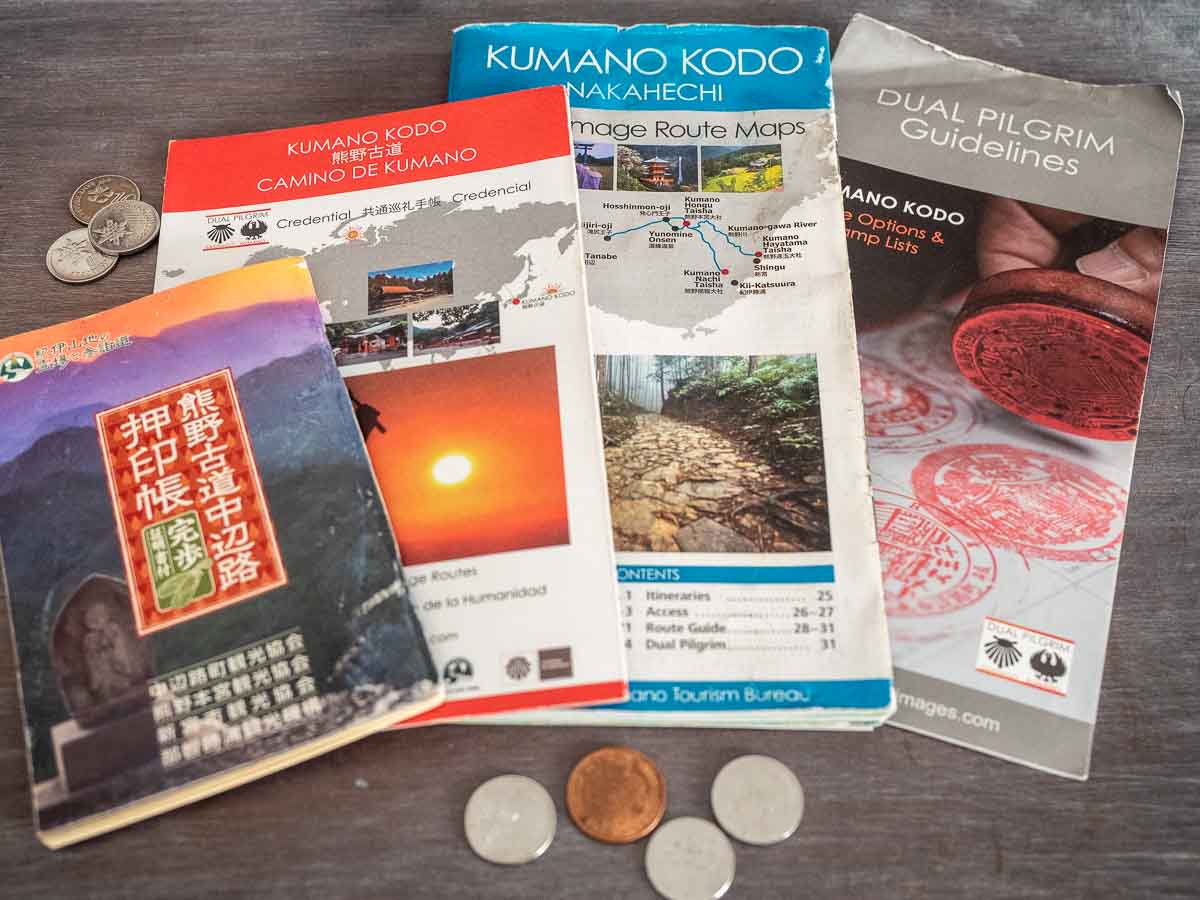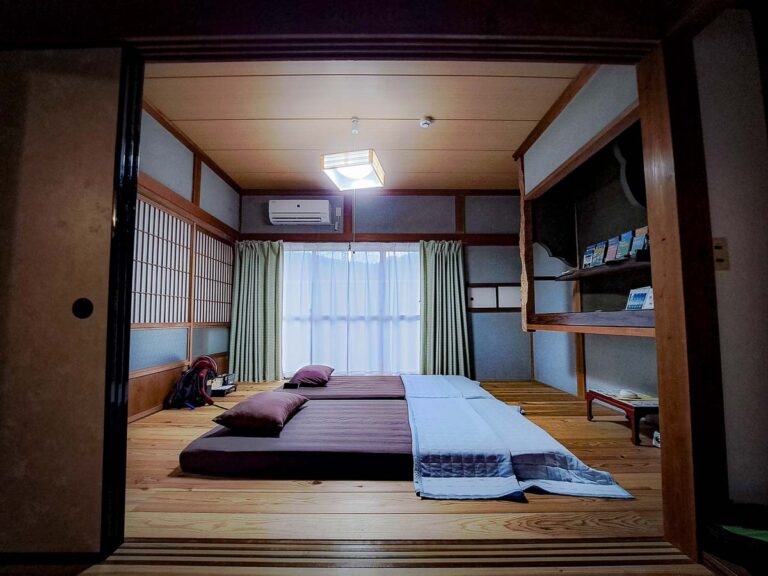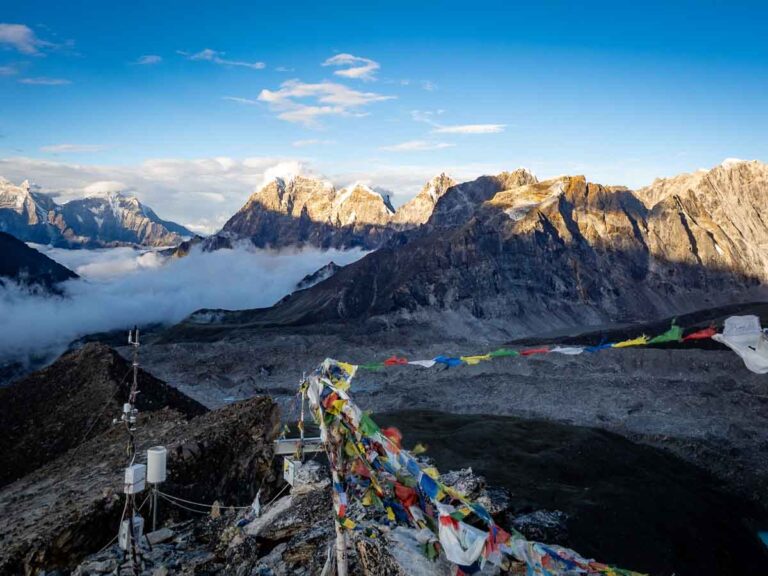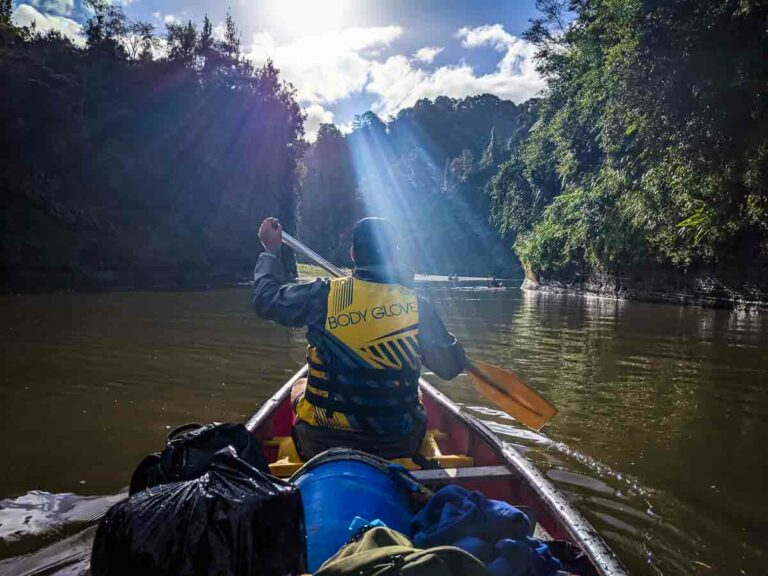Kumano Kodo Cost (How Much It Cost Me For 6 Days Hiking)
The Kumano Kodo is an epic UNESCO world herritage listed pilgrimage hike in the Wakayama district of Japan. It’s a sister hoke to the Camino de Santiago in Spain.
I walked the Kumano Kodo in the summer of 2023 and paid approximately 650USD for the experience. By far the largest expense is accommodation which was roughly 80USD per person per night. Then was transportation as getting to and from this remote part of Japan is not cheap. You’ll also want to set money aside for snacks, drinks and a packed lunch if your accommodation doesn’t allow it.
Fortunately, there are no park fees required to walk the trail.
| Kumano Kodo Expense | Per Person Cost |
|---|---|
| Accommodation: 6 Nights booked through Kumano Travel | $428 |
| Transportation: Train and bus fares from Osaka and back | $139.80 |
| Food and Drink: Snacks, drinks, celebratory beers, and meals where not provided by the Ryokan | $80 |
| Trail Fees: It costs nothing to walk the Kumano Kodo (yay!) | $0 |
| Luggage Transfer: Sending a bag to Kii Katsura | $20 |
| Total | $649 |
Key Takeaways
Read More: You can read my complete guide to the Kumano Kodo here or check out some of my other detailed guides below.
Table of Contents

Kumano Kodo Trail Map
Celbrate your Kumano Kodo experience with this minimalist trail map of the Nakahechi Route (designed by me!) – showing all the key locations, start and end points, and trail stats at the bottom 🙂
The 5 Main Costs Of The Kumano Kodo
The Kumano Kodo is a series of ancient pilgrimage routes located in the Kii Mountain range of Japan, primarily in Wakayama Prefecture, but also extending into Mie and Nara Prefectures 1. There are 3 main routes for the Kumano Kodo The Nakahechi Route (Imperial Route), Kohechi (mountain route), Iseji (coastal route)
Since there are multiple Kumano Kodo trails, and different route options taking any number of days, the cost will vary entirely based on what you plan to do.
The main costs you’ll encounter are broken down into the following;
- Travel Expenses
- Accommodation Costs
- Meal Expenses
- Guide Fees
- Trail Fees
- Miscellaneous expenses.

1. Travel Expenses
Getting to the Kumano Kodo area usually involves flying into a major city like Tokyo or Osaka, and then taking local transportation to the trailhead.
Domestic flights within Japan can range from $0 to $300, depending on the season and availability. Trains and buses are typically the most common transport options for getting to the trailhead. The Kii peninsula region is accessible by train and bus, with prices ranging from $50 to $100 for a one-way trip.
The Nearest major airport is Osaka Kansai Airport, so you’ll want to fly there if arriving internationally or traveling from another part of Japan.
From there, the best way into the Kii Pen is by train. We took the Kuroshio 21 Limited express service from Osaka to Kii Tanabe station which cost 4920 Yen / 32 USD.
To get to the various trailheads you’ll need to take a local bus. The bus from Kii Tanabe to Takajiri Oji was 970 Yen (around 6.60 USD).To get from Nachi Falls back into Katsuura was 630 Yen / 4.2 USD
The return train is a long one. Again, we took the Limited Express Kuroshio 22 which was a 2 and a half hour trip costing 7260 Yen / 49 USD – Ouch!!
All up, we spent $139.80 USD each getting to and from the Kumano Kodo Hike.
Here’s a table breaking this down into more detail
| Journey Leg | Cost |
|---|---|
| Flight from Tokyo to Osaka | $48 USD |
| Train from Osaka Kansai Airport to Kii Tanabe Station | $32 USD |
| Bus from Tanabe to to Takajiri Oji / Kumano Visitior Centre | $6.6 USD |
| Bus from Nachi San to Kii Katsuura | $4.2 USD |
| Train from Kii Katsuura to Osaka$ | $ 49 USD |
2. Accommodation Costs
During our hike on the Kumano Kodo, we highly recommend staying in local guesthouses, ryokans (traditional Japanese inns), or minshukus (family-run lodgings). These accommodations offer a more authentic experience, and prices generally range from $50 to $150 per night. Many of these places include breakfast and dinner as part of their fees, adding value to the overall cost.
| Accommodation | Booking Link | City | Type | Cost PP |
|---|---|---|---|---|
| DJANGO Hostel & Lounge | Book On Booking.com | Tanabe | Hostel / Hotel | $25.96 |
| Guest House AGAE | Book On Kumano Travel | Chikatsuyu | Guest House | $79.83 |
| Blue Sky Guesthouse | Book On Kumano Travel | Hongu | Guest House | $57.23 |
| Koguchi Shizen-no-Ie | Book On Kumano Travel | Koguchi | Minshuku | $69.03 |
| Minshuku Wakatake | Book On Kumano Travel | Central Katsuura | Minshuku | $73.75 |
3. Meal Expenses
If our accommodation does not include meals, we can expect to spend around $10 to $20 per meal at local restaurants along the trail. The food options on the Kumano Kodo include traditional Japanese dishes, such as soba noodles, sushi, or tempura. It is also a good idea to carry some snacks, like onigiri (rice balls) and energy bars, which can be purchased at convenience stores for around $1 to $3 each.
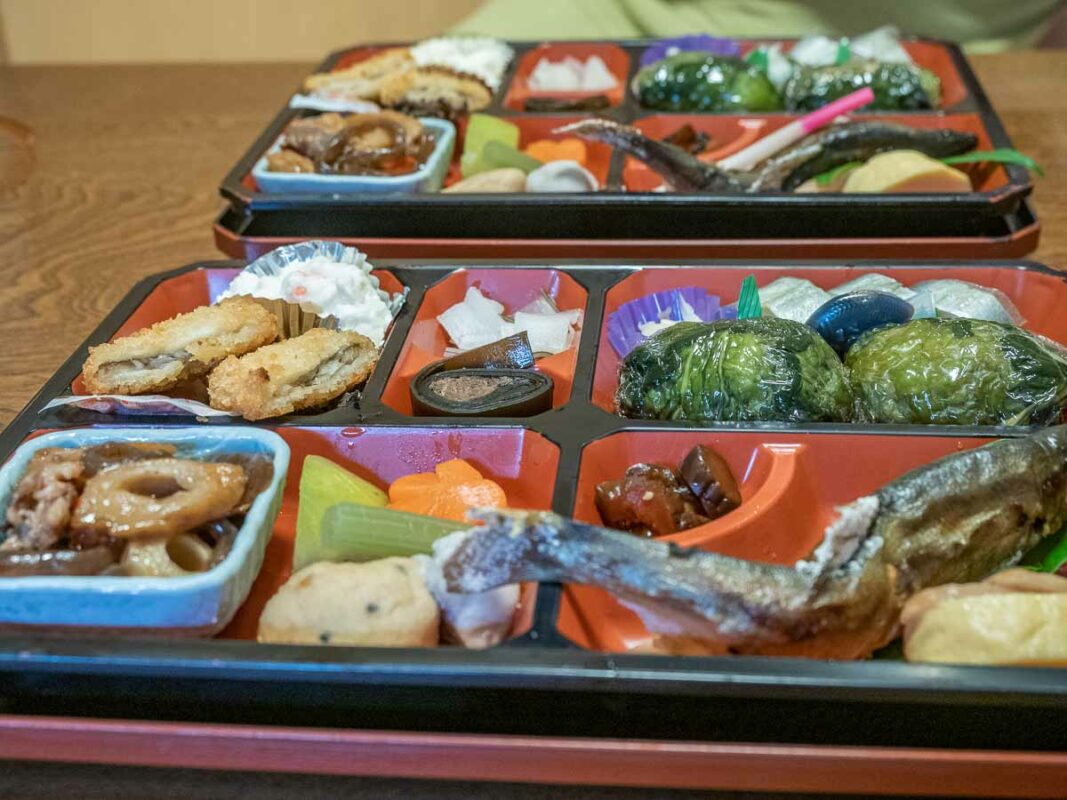
4. Professional Guide Fees
Hiring a professional guide for the Kumano Kodo can enhance your experience.. but it can also completely ruin it!
It’s going to depend on the type of person you are, and what you’re hoping to get out of the journey.
Guides can provide valuable insights into the cultural and historical aspects of the trail. Guided tours typically range from $500 to $1500 per group, depending on the number of people and the length of the trek. Some trekking companies also offer self-guided packages, which include detailed maps, pre-booked accommodations, and luggage transfers for a lower cost.
The owner of our accommodation in Chikatsuyu does guiding on the side and we spent the morning with here as she took us to the start of the trail and explained the significance of this first Oji. We’d totally recommend her if you’re looking for a friendly and experienced local with great english (rather than a package tour).
5. Trail Fees
The Kumano Kodo itself does not have any entrance or trail fees, making it an affordable hiking destination. Nevertheless, we may need to pay small fees for using certain amenities, such as public restrooms or hot springs. These costs are generally minimal, ranging from $1 to $5.
This is awesome as some other famous hikes I’ve done like Kilimanjaro have extortionate park fees charged by the government.
6. Potential Additional Costs
6a. Emergency Care Costs
When planning for a hike on the Kumano Kodo, it’s essential to consider the potential costs of emergency care. Accidents and illnesses can happen, and even if we are well-prepared, it’s a good idea to have a financial safety net in case of emergency. I recommend looking into travel insurance options that cover hiking in Japan and include medical expenses.
Tip: Check your travel insurance covers hiking specific to what the kumano kodo entails. Some insurers won’t cover ‘multi-day’ hiking for example but will cover day walks.
Recommendation: I personally use XXX
6b. Equipment and Gear
Proper equipment and gear are crucial to a successful Kumano Kodo hike. To make our journey comfortable and safe, we will need reliable hiking shoes, a backpack, appropriate clothing for the season, rain gear, and other essentials like a water bottle and a hat. Some of these items may require an upfront investment, especially if we are new to hiking. However, investing in high-quality gear is worth it for our comfort and safety on the trail.
- Hiking shoes: Dependable, well-fitting shoes provide better traction and prevent blisters.
- Backpack: A comfortable backpack with proper support will help carry our essentials without strain.
- Clothing: Weather-appropriate attire is vital for staying warm, dry, and protected from the elements.
Read More: Checkout this guide I wrote that covers my full Kumano Kodo packing list.
6c. Souvenirs and Extra Activities
While hiking the Kumano Kodo, you’ll come across many opportunities to purchase souvenirs or participate in extra activities. These costs can vary depending on our preferences and the activities we choose. Examples include:
- Local crafts: Buying unique items made by artisans in the region.
- Cultural experiences: Taking part in traditional Japanese activities like tea ceremonies or calligraphy workshops.
- Extra excursions: Visiting nearby attractions, such as hot springs or temples, not directly on the trail.
6d. Baggage Transfer Service
If you don’t want to cary your gear each day, and would be more comfortable with a day pack you can opt for a luggage transfer service to take your bags to each destination ahead of time.
Or, like we did, you can get you ‘rest of japan’ luggage sent to the very end so you only cary what you need for the hike.
Read More: You can learn more about the Kumano Kodo baggage transfer service here
| Transfer | Price |
|---|---|
| Tranfer from Kii Tanabe to Kii Katsura | $20 USD |
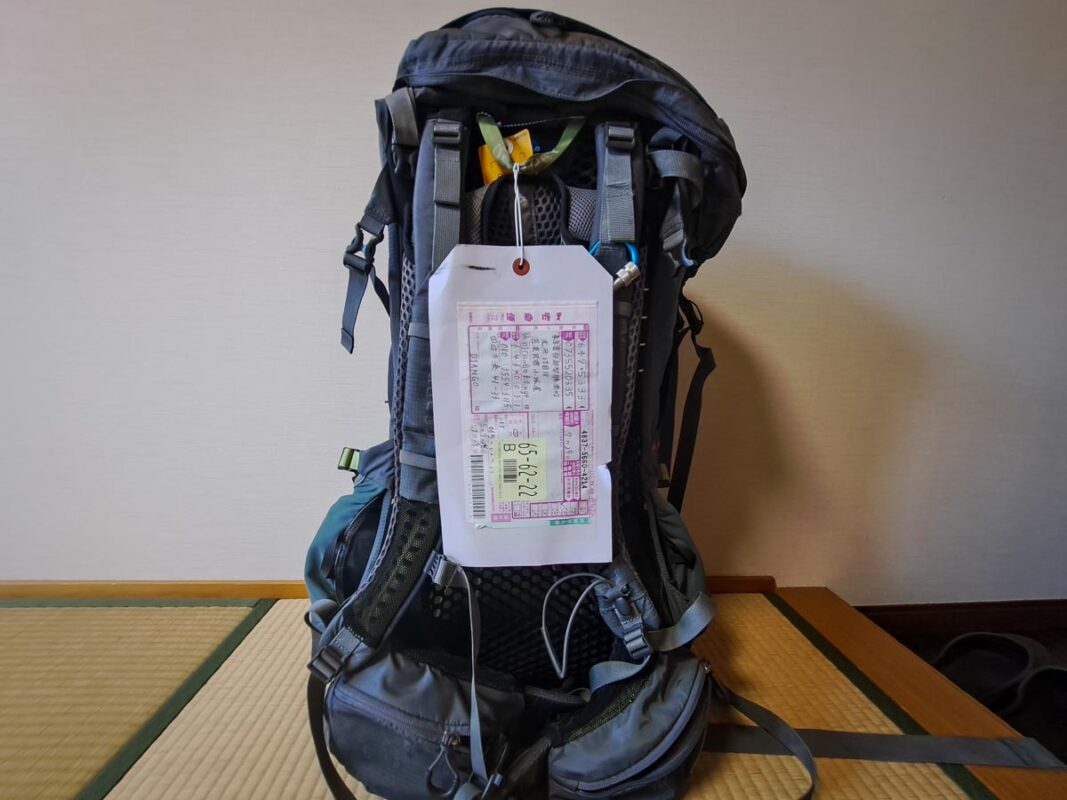
6e. Local Busses
If you’re planning to catch a bus to the start and end of the trail (or want to skip some sections in between) you can jump on one of the many local bus services in the area.
We took the bus from Tanabe to Takajiri Oji to start the trail, and from the end at Kachi Falls to Kii Katsura.
These busses only take cash, so again you’ll want to make sure you take out sufficient money before the hike. You will be unlikely to find any ATMs along the way!
| Bus | Fare |
|---|---|
| From Kii Tanabe to Takajiri Oji | 490 YEN |
| From Nachi Falls to Kii Katsuura | 630 YEN |
How to Budget for the Trip
So the info above is what I paid.. but might not be very helpful if you’ve elected to do a different route or take a different number of days.
Here’s some general guidance to help form a budget before you get too carried away booking 🙂
Accommodation
Accommodation options along the Kumano Kodo trail can range from $20 to $200 per night. There are smaller Japanese inns, known as minshukus, and even though they might not have an online presence,
Allow $75 USD per night per person
Transportation
Getting to and from the trailhead can be a major expense. Be sure to research public transportation options, like trains and buses, as well as potential routes. If you plan in advance, you might be able to take advantage of discounts for early bird bookings or package deals. During your hike, there are local buses available to connect different sections of the trail. We recommend purchasing a bus pass for the duration of your trip that includes unlimited rides on the local buses, as it can be a more cost-effective solution.
Allow at least $100 USD to get to and from the hike from Osaka.
Food
You’ll need to budget for food while hiking the Kumano Kodo. You can expect to spend around $20 to $40 per day on meals if you dine in local establishments along the route. To save more on food costs, consider bringing your own snacks and eating at convenience stores, which are abundant in the region.
If you’ve opted for a food package with your accommodation, allow $10-20 USD for snacks and drinks each day. If you’re self catering, allow $30-40 USD each day for meals
Miscellaneous expenses
It’s always a good idea to budget for additional expenses, like souvenirs, emergency supplies, or tips for local guides (if you hire one).
Allow another $100 to $200 for such unplanned expenses to ensure you’re covered throughout your journey.
5 Tips to Reduce Your Kumano Kodo Costs
One of the first things you should consider is opting for a DIY hiking experience instead of joining an organized tour. This can save you quite a bit of money and it’s what most people chose to do.
Tip 1: Save On Accommodation Costs
Accommodation is a significant cost factor when hiking the Kumano Kodo. Instead of staying at the more traditional ryokans or minshukas, which can cost around 10,000 JPY per night, consider opting for more affordable guesthouses or hostels. Doing so can quickly make your trip more cost-effective, especially if you plan to spend multiple nights on the trail.
Another option is to opt to camp at the many capsites along the way, inseatd of staying in accommodation. The downside to this is you’ll need to figure out all your own food, and will need to cary a tent, sleeping bag, and ground mat for the duration of your hike.
Tip 2: Luggage Transport
Another opportunity to save money is by considering luggage transportation options. There are services that can shuttle your baggage between accommodations on the trail, but this may add extra expense. If you can pack lightly and carry your own belongings, you’ll free up funds for other aspects of your trip.
My Reccomendation: I recommend you don’t rely on a luggage transfer service for every leg of the trip. This is a lot of admin, and an additional cost. Instead; just get your main bag transported from your first accommodation to your last one (for us this was from Tanabe to Katsuura) and then pack a super light hiking bag for the days you’ll be walking.
Tip 3: Avoiding Peak Season
Lastly, consider off-peak travel times for your hike. The Kumano Kodo attracts fewer visitors during the colder months, which often leads to lower prices on accommodation and services. Be aware, though, that some trails may be more challenging during these periods due to weather conditions, so always research and plan accordingly.
Frequently Asked Questions About the Cost of Hiking Kumano Kodo
There is no fixed cost for hiking the Kumano Kodo, as it varies depending on several factors such as accommodation, transport, and food expenses. In this section, we will address some frequently asked questions about the cost of hiking Kumano Kodo.
Q. How much should I budget for accommodations?
Accommodations along the Kumano Kodo range from budget guesthouses to luxurious ryokans. You can expect to spend between 6,000 to 25,000 yen per night, including meals (source). Keep in mind that prices may vary depending on the season, and it is a good idea to book in advance.
We paid a total of $$ per person for 5 nights accommodation along the Nakahetchi Route.
Q. What transportation expenses should I consider?
Many people choose to use public transportation, such as buses and trains, to travel to and around the Kumano Kodo. A round-trip bus fare from Osaka to Tanabe, for example, costs around 8,000 yen. Additionally, you can purchase a 3-day Kumano Kodo Bus Pass for 5,500 yen to have unlimited access to the local bus network.
What I Paid:
| Journey Leg | Cost |
|---|---|
| Train from Osaka Kansai Airport to Kii Tanabe Station | $32 USD |
| Bus from Tanabe to to Takajiri Oji / Kumano Visitior Centre | $6.6 USD |
| Bus from Nachi San to Kii Katsuura | $4.2 USD |
| Train from Kii Katsuura to Osaka$ | $ 49 USD |
Q. Are there any entrance fees for the trails or shrines?
Visiting the Kumano Kodo shrines and walking the trails is generally free of charge. However, for many shrines its customary to make a small coin dontation before making your prayer. If you want to join in the practice, then it’s a good idea to keep some coins handy.
Q. How much should I budget for meals?
Meals can range from inexpensive convenience store food to higher-priced restaurants. On average, you should budget approximately 1,000 to 2,500 yen per meal. Don’t forget to try the delicious local cuisine that can be found in many family-owned restaurants along the trail.
Q. Are there any additional costs to consider?
If you prefer to hike with a guided tour, this will add to the cost of your trip. Guided tours can range from 20,000 to 100,000 yen, depending on the length and services included. You may also consider using a luggage transport service if you don’t want to carry your bags while hiking; this service usually costs around 1,000 to 2,000 yen per piece of luggage, per destination
Final Thoughts And Recommendations
I hiked the Kumano Kodo in July 2023 and in total it cost approximately 95,000 Yen or 649 USD.
The biggest expense by far is accommodation, then transportation to and from this remote part of the country. Food from convenience stores is pretty cheap, and there are no government or park fees required for hiking the trail.
To minisimse your expenses you can consider choosing cheaper accommodation or camping, eating from the 7-Eleven-type convenience stores, carrying your belongings rather than using a luggage transfer service, and travelling by local train rather than the limited express services.
I hope you’ve enjoyed this guide. Please let me know in the comments below how much your kumano trip cost and if the tips in the article were helpful to you.
Kumano Kodo Travel Planning Cheatsheet
🚑 Should I buy travel insurance for Japan?
100% YES! — Japan has “free” healthcare but it’s only for citizens! Tourists need travel insurance in case anything happens on your visit. Also be aware many policies won’t cover hiking as it’s a high risk activity! (that’s right, check the t&c’s on your complimentary credit card insurance)
I highly recommend World Nomads as you can get specific add-ons for the crazy activities you’re doing – and starts at just $7 a day!
🏩 What’s the best way to book my Kumano Kodo accommodation?
Your only realy two options here are Kumano Travel and Booking.com. Its a complicated process so I wrote this guide here on the best kumano kodo accomodation options
If you don’t want to figure it all out (it’s meant to be a holiday after all) you can book a package tour. Here are my recommendations for both guided and self-guided.
💸How do you pay for things in Japan?
Japan may have flying robots.. but they also still use cash! So you’ll want to get some folding tender out from an ATM when you land. EFTPOS / Debit / Credit Card and Paywave (contactless payments) is common at bigger businesses but small bars, and street vendors want cash.
I personally use a Wise debit card for all my international money needs as they only convert the funds when you make payment, plus they offer a much better spread (margin on the true exhange rate) than the banks do. They work in all Japanese ATMs I tried.
🚙 Do you need to rent a car in Japan?
I wouldn’t reccommend it — Transport in Japan is expensive whatever mode you chose, but fortunalty the publc transport system is out of this world in terms of both freqency and coverage. If you are heading to a lot of off the beaten track places, then you may want a rental. I use Discover Cars to find the cheapest rates on rentals cars and remember you can save money if you avoid picking up at the airport.
🚆 What about the JR Rail Pass?
We didn’t – but it depends on the length and itenirary of your trip. The JR Pass is expensive (and just went up in price again!) and if you’re walking the Kumano Kodo you wont need it for probably 6 days straight anyway.
Do the math, but in most cases buying the train fares you need, when you need it will work out more afforably overall – and give you more flexibility (as the JR Pass doesn’t cover all lines)
📲 How do I get internet/data/wifi in Japan and on the trail?
This one needs a whole nother article, but the short version is;
- local SIM cards are cheaper but generally require a fixed term contract (not practical for people visiting)
- Tourist ‘short stay’ SIMs are a bit more expensive but will give you plenty of data while your visiting and are best for solo travelllers.
- If you’re travelling as 2 or more people, renting a pocket WIFI unit from the airport is the most economical option – Works out cheaper than getting two tourists sims
- Use a travel eSIM like Saily or Airalo. This works from the moment you land is is SOOOOO much easier than trying to pick a data pack in japanese. It also gives you connectivity across neighbouring asian countries if you buy a regional sim! TIP: I used to use Airalo but now find Saily a much better product – you can get 5% off with code SPECIAL5
✈️ What’s the best site to buy flights to Japan?
For finding cheap flights, I recommend Skyscanner. Once you find the flight you’re looking for, I’d then suggest booking directly with the carrier (even if it costs a few $$ more than with one of the agreggators/agencies).
💧Can you drink the water on the Kumano Kodo?
Yes — Japan is very clean. In all townships you’ll pass through and stay along the Kumano Kodo the tap water is drinkable. If you want to drink water from the rivers and streams you generally can but should do so at your own risk. ALWAYS follow best practice and drink from fast flowing water as far up stream as possible. I drank the water and was fine.. but i’d generally recommend a Brita Water Bottle for rehydrating on the trail safely.
🎫 Do I need a visa for Japan?
Likely Not — Japan now recognises 70 countries as ‘visa exempt’ for short term stay. So if you’re a US, UK, NZ, AU and EU passport holder you don’t need a Japansese visas. However, some other countries do (check here!). And if you plan to stay for more than 90 days (an average tourist visa length), you will need to look into the Japanese working holiday visa scheme, or the new Digital Nomad visa scheme.

